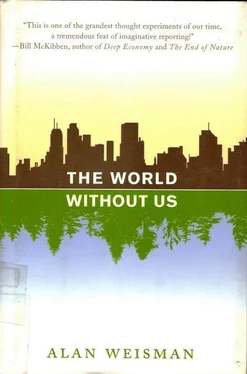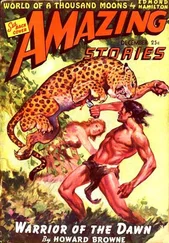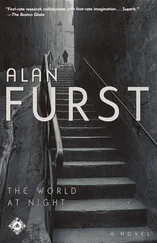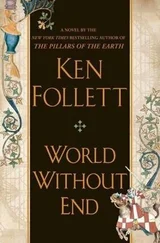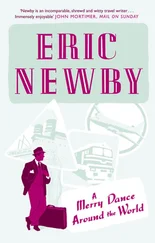They touch down lightly, disturbing no buried hair-triggers. Revered in Asia as sacred portents of luck and peace, the red-crowned cranes are blissfully oblivious trespassers who’ve wandered into the incandescent tension of 2 million troops faced off across this accidental wildlife sanctuary in bunkers every few dozen meters, mortars poised.
“Babies,” Kyung-Won whispers, and the lenses fix on two juvenile cranes wading in a streambed, their long bills rooting underwater for tubers, their crowns still juvenile brown. Only around 1,500 of these birds still exist, and each new birth is momentous.
Behind them, in a North Korean version of the Hollywood sign, the hills sprout whitewashed Korean characters that proclaim the supremacy of Dear Leader Kim Jong-il and loathing for America. Their enemies retort with giant marquees whose thousands of lightbulbs flash messages visible for miles about the good life in the capitalist South. Every few hundred meters between observation posts bursting with propaganda is another armed bunker, with eyes peering through a slit at some opposite number across the chasm. The confrontation has burned through three generations of enemies now, many of them blood relatives.
Through all this menace float the cranes, landing in the sunny flats on both sides of the demarcation line to serenely graze on reeds. None of these men, rapt at the sight of such magnificent winged eminences, would ever admit to praying against peace, but the truth is that if not for the seething hostilities that keep this zone clear, these birds would likely face extinction. Just to the east, the suburbs of Seoul—a juggernaut approaching 20 million Homo sapiens —roll ever northward, banging into the CCZ, with developers poised to invade this tantalizing real estate whenever the concertina wire comes down. And North Korea, edging toward China’s example, has collaborated with its capitalistic archfoes on a border industrial megapark to tap its most abundant resource: hungry multitudes who will work cheap—and who will need housing.
The ecologists spend an hour watching the regal, nearly five-foot-tall birds in their element. All the while, they themselves are under the unblinking scrutiny of cheerless soldiers charged to defend the border. One approaches to inspect their tripod-mounted, 40-power Swarovski spotting scope. They show him the cranes. As he squints, with his muzzle-mounted grenade launcher pointing skyward, tinted afternoon shadows slant across North Korea’s bare mountainsides. A shaft of sunlight spears a white, battle-scarred ridge called T-Bone Hill, which juts up from the contested plain between the two halves of Korea. The soldier tells them how many heroes died defending it, and how many more of the hated enemy were slain.
They’ve heard this before. “Besides the difference between North and South Korea, you should tell people about the ecosystem we share,” Ma Yong-Un replies. He points to a water buck ascending the grassy slope. “One day this will all be one country, but there will still be reason to protect it.”
They return through a long, flat Civilian Control Zone valley carpeted with rice stubble. The soil is scored into herringbone furrows separated by glinting mirrors of early snowmelt that will re-freeze by nightfall. By December, temperatures will descend to -20°F. The sky is hatched with patterns echoing the ploughed geometries below as lines of cranes soar in, joined by great airborne wedges of thousands of geese.
As the birds descend for an afternoon meal of rice harvest remains, the group stops for photographs and a quick census. There are 35 red-crowned cranes, looking straight out of a Japanese silk painting: glowing white, with cherry skullcaps and black necks. There are also 95 pink-legged, white-naped cranes. There are three species of geese: upland, bean, and some rare spotted snow geese, all protected from hunting in South Korea, so many that no one bothers counting them.
Thrilling as it was to spot cranes in the recovering natural DMZ wetlands, it’s far easier in these adjacent tilled lands, where they can feast on grains missed by mechanized harvesters. Would these birds benefit or suffer if humans were to disappear? Red-crowned cranes evolved to nibble reed shoots, but by now thousands of generations have been fed in human-engineered wetlands called rice paddies. If there were no more farmers, and if the bountiful rice fields of the CCZ also revert to marshes, would crane and geese populations decline?
“A rice paddy is not an ideal ecosystem for these cranes,” declares Kyung-Won, looking up from his spotting scope. “They need roots, not just grain. So many wetlands have turned into farms, they have no choice but to eat this for energy to survive winter.”
In the DMZ’s abandoned rice paddies, not enough reeds and canary grass have reappeared to support even these critically diminished populations, because both Koreas have built dams upstream. “Even in winter they pump water to grow vegetables in greenhouses, when the aquifers should be replenishing with snowfall,” says Kyung-Won.
If there were no agriculture trying to feed 20 million humans in Seoul, let alone North Korea, pumps that defy the very seasons would be stilled. Water would return, and wildlife with it. “For plants and animals, it would be such a relief,” says Kyung-Won. “A paradise.”
Like the DMZ itself: a killing place that became a haven to nearly vanished Asian creatures. Even the all-but-extinct Siberian tiger is rumored to hide here, though that may just be wishful dreaming. What these young naturalists want is exactly what their counterparts in Poland and Belarus beg for: a peace park, transmuted from a war zone. A coalition of international scientists called the DMZ Forum has tried to convince politicians of the potential for a face-saving peace, and even profit, if Korea’s two enemies together consecrate the one good thing they share.
“Think of a Korean Gettysburg and Yosemite rolled together,” says DMZ Forum co-founder, Harvard biologist E. O. Wilson. Even with the expensive prospect of clearing all the land mines, Wilson believes that tourism revenue could trump agriculture or development. “A hundred years from now, of all the things that happened here in the last century, what will matter most will be that park. It will be the legacy most treasured by the Korean people, and an example for the rest of the world to follow.”
It’s a sweet vision, but one on the verge of being swallowed by subdivisions that already crowd the DMZ. The Sunday after he returns to Seoul, Ma Yong-Un visits the Hwa Gye Sah Temple in the mountains north of town, one of Korea’s oldest Buddhist sanctuaries. In a pavilion adorned with carved dragons and gilded Bodhisattvas, he hears disciples chant the Diamond Sutra, in which Buddha teaches that all is like a dream, an illusion, a bubble, a shadow. Like the dew.
“The world is impermanent,” the gray-robed head monk, Hyon Gak Sunim, tells him afterward. “Like our body, we must let go of it.” Yet, he assures Ma Yong-Un, to try to preserve the planet isn’t a Zen paradox. “The body is essential for enlightenment. We have an obligation to take care of ours.”
But the sheer number of human bodies now makes caring for the Earth a particularly perplexing koan. Even the once-sacrosanct tranquility of Korea’s temples is under assault. To shorten the commute into Seoul from outlying suburbs, an eight-lane tunnel is being dug directly beneath this one.
“In this century,” insists E. O. Wilson, “we’ll develop an ethic of letting population gradually subside, until we reach a world with far less human impact.” He says this with the conviction of a scientist so steeped in probing the resilience of life that he claims it for his own species as well. But if land mines can be swept for tourists, real estate mongers will scheme for the same prime property. If a compromise results in developments surrounding a token history-nature theme park, the only viable species left in the DMZ will likely be our own.
Читать дальше
